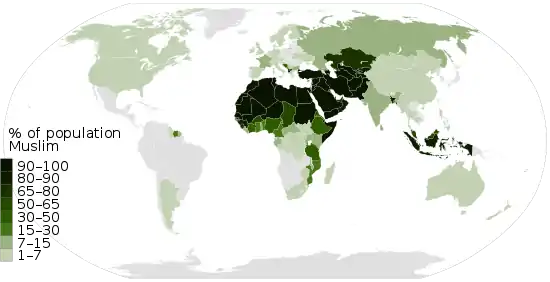Islam in Finland
Islam is a minority religion in Finland. The first Muslims were Tatars who immigrated mainly between 1870 and 1920.[1] After that there were decades with generally a small number of immigration in Finland. Since the late 20th century the number of Muslims in Finland has increased rapidly due to immigration. Nowadays, there are dozens of Islamic communities in Finland, but only a minority of Muslims have joined them. Pew Research Center estimates that in 2016 about 2.7% of Finland's 5.5 million population is Muslim. The real percentage is said to be 1.8% if counting together all language groups. In the high migration scenario, Finland's Muslim population could grow to 15% by 2050 which would equal almost a million Muslims in Finland.[2] In December 2017 the city of Helsinki rejected a proposal to build a large mosque financed by funds from Bahrain. The application was rejected as it was unclear which movement of Islam would dominate its prayers and the attendant risk of radicalization and conflict between different religious communities.[3]
| Islam by country |
|---|
 |
|
|
Baltic Tatars
The Baltic Tatars arrived in Finland as merchants and soldiers at the end of the 19th century. They were later joined by other family members. The Finnish Islamic Association (Finnish: Suomen Islam-seurakunta) was founded in 1925. In practice, this society only accepts people from Tatar origin, or Turkic origin in general, as members, excluding non-Turkic speaking Muslims. The Finnish Tatars's Islamic congregations have a total of about 1,000 members these days.[4]
Modern immigration
The number of immigrants, and Muslims as well, in Finland rose considerably in the early 1990s. Soon new immigrants established their own mosques and societies. In 1996 these groups came together to form a cooperative organ - the Federation of Islamic Organizations in Finland. It is estimated that approximately 1,000 Finns have converted to Islam. The vast majority of these are women who have married Muslim men.[4]
Hundreds of Muslim asylum seekers and refugees from Iraq and Afghanistan convert to Christianity after having had their first asylum application rejected by the Finnish Immigration Service (Migri), in order to re-apply for asylum on the grounds of religious persecution.[5]
In May 2018, the Minister of Justice Antti Häkkänen responded to academics who had demanded that sharia law and other laws from foreign cultures be incorporated into the justice system of Finland. He stated that "religion or culture can never justify abuse of women and children, such as female genital mutilation or child marriage. There is no place for Sharia law or parallel societies in Finland. Human rights apply to all equally."[6]
Islamic societies
| Name | Registered | Home | Members |
|---|---|---|---|
| Finnish Islamic Association | 1925 | Helsinki | 567 |
| Islamic Society of Finland | 1987 | Helsinki | 1 097 |
| Helsinki Islamic Center | 1995 | Helsinki | 1 817 |
| Tampere Islamic Society | 1998 | Tampere | 837 |
| Islamic Rahma Center in Finland | 1998 | Helsinki | 575 |
| Islamic Society of Northern Finland | 2000 | Oulu | 361 |
| Resalat islamilainen yhdyskunta | 2001 | Vantaa | 486 |
There are dozens of independent Islamic societies in Finland. The oldest one is Finnish Islamic Association which was established in 1925. It has about 700 members of whom all are Tatars. The society has mosques in Helsinki, Tampere and Lahti. The only building established only as mosque in Finland is Järvenpää Mosque.
The Islamic Society of Finland was established in 1987. Its members are mainly Arabs, but also Finnish converts. The society has a mosque and Koran school in Helsinki. The Helsinki Islamic Center is currently the biggest society with almost 2,000 members. Furthermore, there are a dozen other Islamic societies in Helsinki region, some of them are not officially registered.

Most of mosques are multilingual, but the most commonly used languages are usually English and Finnish. Religious services are held in Arabic.
Demographics
The population of Muslims in Finland from 2008 to 2018 ,according to the Statistics Finland:[8]
| Year | Population |
|---|---|
| 2008 | 40.000 |
| 2010 | 45.000 |
| 2012 | 50.000 |
| 2014 | 60,237 |
| 2016 | 110.000 |
| 2018 | 136.000 |
Muslim majority ethnic groups by language
Numbers are based on the Statistics Finland (language, 2019).[9]
- Arabic language (30,467)
- Somali language (20,997)
- Kurdish language (14,327)
- Persian language (12,090)
- Albanian language (10,391)
- Turkish language (7,739)
- Bengali language (3,599)
- Urdu language (2,983)
- Bosnian language (2,322)
- Punjabi language (1,028)
- Chechen language (636)
- Uzbek language (604)
- Indonesian language (589)
- Azerbaijani language (467)
- Turkmen language (447)
Total: 102,696
Gallery
 6 Islamic, 15 English, and 76 German coins, latest coin dates from 1006-1029 - National Museum of Finland
6 Islamic, 15 English, and 76 German coins, latest coin dates from 1006-1029 - National Museum of Finland
See also
References
- Mason, Robert (2016-04-08). Muslim Minority-State Relations: Violence, Integration, and Policy. Springer. ISBN 978-1-137-52605-2.
- "Muslim Population Growth in Europe". pewforum.org.
- "Stadsmiljönämnden säger nej till stormoské i Helsingfors" (in Swedish). Retrieved 2017-12-14.
- The Evangelical Lutheran Church of Finland: Other Churches and Religions in Finland Archived 2010-10-05 at the Wayback Machine
- "Stort finländskt fenomen - hundratals muslimer blir kristna". 4 October 2017. Archived from the original on 21 April 2018.
- "Justitieministern slår tillbaka mot kraven: "Inget utrymme i Finland för sharialag"". Ålands Nyheter (in Swedish). 2018-05-25. Retrieved 2018-07-22.
- Uskonnot.fi (In Finnish) Keyword "islam". 16.8.2010
- https://www.statista.com/statistics/533055/annual-number-of-individuals-identifying-as-muslim-in-finland/
External links
| Wikimedia Commons has media related to Islam in Finland. |
- Report on Islam: Finnish Islam arises slowly (in Finnish).
- Finnish Islamic Congregation (in Finnish).
- Some of the mosques in Finland (map)